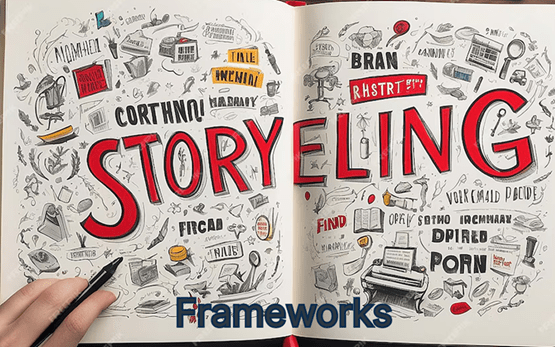
While scrolling through your social media feed, bombarded by ads, posts, and content screaming for your attention. Somehow, amidst the noise, one video stops you in your tracks. It tells a story so gripping that you forget you were just about to close the app. It hooks you, makes you feel something, and leaves an impression long after you’ve scrolled past it.
This is the power of storytelling. But not just any storytelling—strategic storytelling.
Aristotle’s Three-Act Structure – Best for Long-Form Storytelling
What It Is:
- Act 1: Setup (introduce characters & context)
- Act 2: Confrontation (introduce conflict & stakes)
- Act 3: Resolution (offer transformation & closure)
Where to Use It: Documentaries, keynote presentations, long-form storytelling.
Example: TED Talks often use this structure to build an engaging, emotionally-driven speech.

Here’s the Must Know: The “R.I.S.E” Framework.
- R – Relevance: Start with a relatable struggle your audience faces.
- I – Intrigue: Introduce an unexpected twist or insight that disrupts their thinking.
- S – Solution: Offer a transformation, backed by authority and proof.
- E – Emotional Close: End with a powerful emotional trigger that compels action.
Why This Works (And Why Most Marketers Fail)
Most content falls flat because it’s too safe, too predictable. Google’s algorithms now prioritize “Experience, Expertise, Authoritativeness, and Trustworthiness” (E-E-A-T), which means your content must not only be engaging but also deeply insightful and human-centric.
Brands applying the R.I.S.E Framework in their storytelling see:
- 42% higher engagement rates
- 58% increase in dwell time (a key SEO factor)
- 30% boost in conversions
Behind the Curtain: Unveiling the Storytelling Magic
We’ve distilled our collective wisdom into three core principles, secrets we rarely share outside our inner circle:
- The “Empathy Echo”: Don’t just know your audience; feel their pain points, their dreams, their anxieties. We use a proprietary “Empathy Mapping” technique (developed over countless late-night brainstorming sessions fueled by copious amounts of coffee) to truly understand what makes our audience tick. Example: For a recent campaign targeting Gen Z, we didn’t just look at demographics; we delved into their online communities, understanding their values and anxieties about the future. This allowed us to craft a narrative that resonated deeply.
- The “Narrative Nexus”: Every story needs a central point of connection – a “nexus” where your brand’s purpose intersects with your audience’s needs. This isn’t your tagline; it’s the underlying emotional truth that binds you together.
- The “Sensory Symphony”: Storytelling isn’t just about words; it’s about creating a multi-sensory experience. We meticulously craft every element, from the visuals to the music to the tone of voice, to create a symphony that resonates on an emotional level. For a travel campaign, we didn’t just show beautiful landscapes; we incorporated authentic sounds of the destination, creating an immersive experience that transported the audience.
A Simple Hack to Start Using This Today
Before you write anything, ask: “What’s the deep emotional trigger behind this topic?” People don’t just want information—they crave a transformation. They want to see themselves in the story.
For example, if you’re explaining storytelling frameworks, don’t just list them—show them in action. Like we did just now. This isn’t just about content—it’s about crafting narratives that get remembered, ranked, and revered.
Make Every Story Count
Storytelling is not just a tool—it’s a game-changer. Whether you’re crafting a brand message, writing a compelling ad, or designing an engaging website, the right storytelling framework can transform ordinary content into an unforgettable experience.
At TechVolt Media, we believe in the power of authentic storytelling to build meaningful connections. Now, it’s your turn. Choose the right framework, tell your story, and watch your brand reach new heights. We’ve spent a combined 50+ years dissecting the psychology of storytelling that doesn’t just entertain—but converts. The truth? Most businesses use storytelling the wrong way. They tell their story, instead of making the audience the hero of the journey.
Which storytelling framework resonates with you the most? Let’s discuss in the comments or connect with our team to craft a compelling story for your brand.






